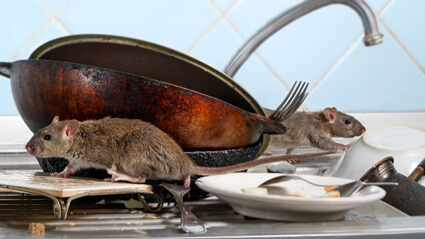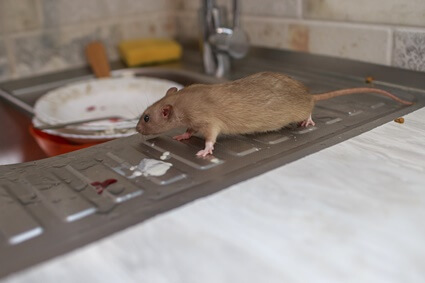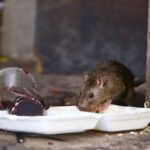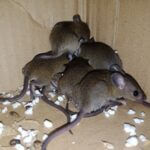Rats are drawn to food, settling in homes with ample scraps. If you want to remove an infestation, it makes sense to secure your food sources.
The problem comes when you’ve packaged up everything yet still have rats. You’d assume the rats would be forced to leave when they can’t access food.
Starving out rats is likely to be ineffective. Rats may leave if there’s no food available within 300+ feet of their nests, but this is unlikely.
It’s rare for a modern home to offer no food sources, and rats eat from the garbage, compost heaps, neighboring homes, and even non-traditional foods.
Healthy rats can survive 3-4 days without food. So, it’s better to combine starving out rats with other pest-control measures to get rid of rodents.
Can You Starve Rats Out?
It’s possible to starve rats out, but it isn’t easy.
Most of us still need to utilize poisons, catch-and-release traps, exterminators, and sealing access points to eliminate rat problems.
Rats are resourceful creatures that can locate food in even well-protected areas. If you eliminate all accessible food in your home and clean the area well, rats may remain nested rather than leave.
To find food, rats will do the following:
- Travel elsewhere, but stay nested in your home.
- Survive on smaller portions.
- Consume items you don’t recognize as food.
Even an otherwise rat-proof home may still provide additional benefits. For instance, rats may stay nested in a place without food as long as they have:
- Safe shelter.
- Warmth.
- Water.
- Pathways to food, such as a compost heap or a neighbor’s home.
The more you try to deny rats access to food, the more bold and desperate they become.

What Do Rats Eat If There Is No Food?
Some rat species, like brown rats, can eat any organic material, even outside the conventional definition of food. They may even consume non-organic material, even if they can’t digest it.
Non-organic foods that rats will eat include:
- Clothing.
- Shoes.
- Insulation.
- Pet feces.
- Paint.
- Aluminum foil.
- Cardboard.
- Wood.
This makes it nearly impossible to starve rats to the extent that they’ll consider moving away.
Rats can gain trace nutrients from non-traditional foods. For example, leather is an animal product, and pet feces contain nutrients your pet hasn’t fully digested. Other targets may include:
- Construction supplies.
- Bits of paper and clothes.
- Piping.
- Dead insects.
- Pet food.
- Kitchen and bathroom garbage.
Rats are a mammalian species that show cannibalistic behaviors when desperate for food. So, starving rats will eat their dead or young if they’re desperate.
Of course, a time may arise when rats have nothing to eat, which may encourage them to move on to better foraging grounds.
It’ll depend on how long their preferred foods remain scarce and how many rats are around.
How Far Do Rats Travel From Their Nests For Food?
Rats can travel 25-100 feet from their nests daily. This is often at night when looking for food and water. In times of hunger, such as when you’re trying to starve them, rats can search for food up to 300 feet away.
Their limitations aren’t just due to the small size of rats but because they have to carry leftover food back to their nests.
Note that 100-300 feet may be enough to access your neighbors. Here, rats may find additional meals and survive, even when you’re starving them out.
Some rats will move the location of their nest if they need food. Others won’t, instead choosing to travel back and forth with food supplies.
Much depends on the following factors:
Mother Rats (Dams)
If the distance between the nest and food sources is significant, female rats with young pups often choose to relocate their nesting places.
This is designed to minimize the energy they use to travel while ensuring they keep their young safe from dangerous predators.
Number of Rats
Population density plays a significant role in the colony’s traveling range. If there are only a few rats, they will have a shorter range, as they can easily find and ration edible items.
Larger populations move more during the day than at night, giving them a more extensive travel range, as they can search for longer hours.
Colony members may be forced out of their nest and search a greater radius out of desperation.
Age of Rats
Adult rats travel longer distances (typically more than 100 feet) because their food needs are higher. If the rat is a juvenile, it’ll seek to stay closer to the nest, even if it needs a meal.
Urgency
Rats are cautious creatures. They dislike moving their nests, only resorting to doing so when they have no choice. Most rats will stay put if the nest is in a safe place.
In a desperate situation, rats make multiple small runs to nearby locations instead of moving their nest to a better place.
Rats will stay in your home and travel to another spot on food-finding missions. They’ll return to your home afterward. However, rats may consider moving permanently to escape:
How Long Do Rats Take to Starve?
Rats can’t survive without food for more than 4 days.
Baby rats can only survive for about 2 days without sustenance. This explains why mother rats with pups will be the first to move out if they sense that food is running low.
Rats are likely to travel for food long before they reach starvation.
It only takes 3-4 days for a rat to die from dehydration. However, the average healthy adult rat only needs to drink about 10ml per 100 grams of body weight.
Various factors contribute to this, including the following:
Unlikely Food
Rats can switch up their diets to cope with certain circumstances.
Even if you keep away all conventional foods, rats will consume non-traditional food to survive. This may include natural substances like wooden furniture, cardboard, and books.
Cannibalism
If there’s a significant infestation, bigger and stronger rats will stay alive by eating the dead bodies of smaller and weaker rats. This mainly happens just after a rat dies and the meat is fresh.
Cannibalism is surprisingly common among new mothers. According to Developing Psychobiology, infanticide rates can be up to 33%.
Food Stores
Some rats store extra food in their nests, allowing them to survive longer when you’re starving them out. Even without new food sources, they have surplus caches.

Best Ways To Starve Out Rats
Starving out rats isn’t an effective means of pest control. However, it can deter the population from growing and keep other rats from settling in. However, you can improve your chances of success.
You need to remove all the food you’ve stored in the following:
- Cartons.
- Cardboard boxes.
- Wooden drawers.
- Sacks.
Even compromised canned foods can be accessed by rats, so throw any damaged tins away.
Store food in tightly closed glass, metal, or plastic containers.
Top that off with steps such as:
- Keep the area around bird feeders clean and remove hedgehog bowls after meals.
- Keep your home free of debris, leaves, pet feces, and wood.
- Seal your garbage can at all times.
- Clean food particles from tables, countertops, floors, and appliances.
- Collect books, papers, and clothes and store them in rat-proof cabinets.
- Inspect your home (including the store, garage, walls, ceiling, and attic) for openings, as rats can squeeze through small spaces.
- Rat-proof holes with hard materials, such as hardwood plates and metallic wire mesh.
These methods will be ineffective if your neighbors don’t go to similar lengths. This is especially so in urban environments, where the distance between neighboring homes is less than 50 feet.
Rats will leave if there’s no food. However, it’s rare for there to be nothing a rat can eat in a modern home, even if it’s non-traditional food fit for human consumption.








